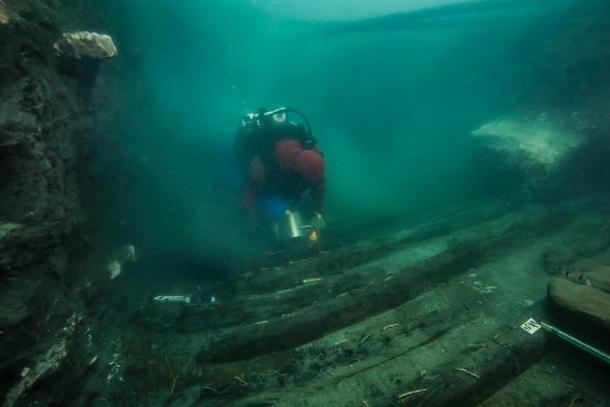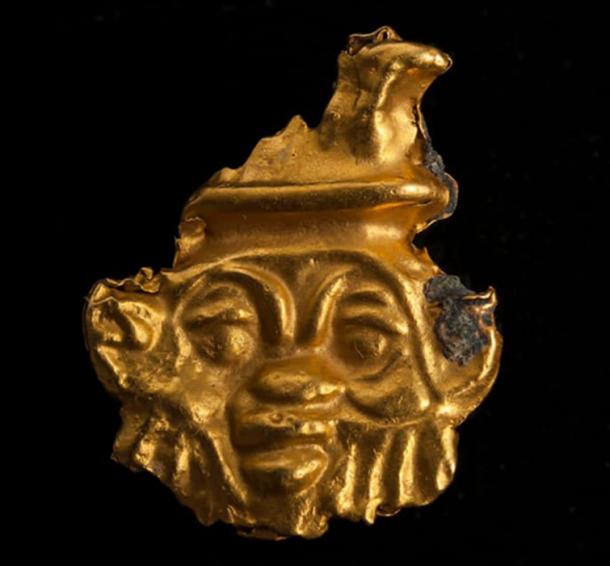The island-city of Thonis-Heracleion and its famous Temple of Amun was located in Egypt’s Abu Qir Bay, just north of Alexandria, Egypt. Greeks later settled in Thonis-Heracleion during the late pharaonic dynasties and built their own religious sanctuaries beside and around the older Egyptian Temple of Amun. The island-city was completely destroyed at the end of the 2nd century BC after several earthquakes, followed by tidal waves, triggered land liquefactions along a 42-square-mile (110-square-kilometer) portion of the Nile Delta.
And thus, the cities of Thonis-Heracleion and Canopus both collapsed into the sea. And both the ancient Egyptian Temple of Amun and the newer Greek sanctuaries fell into a canal that ran in front of the religious complex. These sites are now located under the sea 4.3 miles (7 km) off the modern-day coast of Egypt.
An Egyptian-French underwater archaeological mission, led by the European Institute for Underwater Archaeology (IEASM), have recently excavated at the famous sunken city and a range of new treasures and initial observations have been announced.
Mostafa Waziri, Secretary-General of the Supreme Council of Antiquities, said the submerged city has now yielded not only the remains of a military vessel, but also a funerary tumulus and “beautifully illustrated” burial complex.

The underwater Egyptian military ship recently discovered underwater at Thonis-Heracleion, located in the Nile Delta just north of Alexandria, Egypt. ( Ministry of Tourism and Antiquities )
The Thonis-Heracleion Military Ship Was Sunk By Earthquakes
In 2001 and 1999 respectively, Thonis-Heracleion and Canopus were rediscovered by the IEASM, in collaboration with the Underwater Archaeology Department of Egypt ’s Ministry of Tourism and Antiquities.
Now, Franck Goddio, the French underwater archaeologist who rediscovered Thonis-Heracleion, says the 82-foot-long (25-meter-long) military ship was discovered in the major canal that flowed along the south face of the famous Temple of Amun.
It is believed the ship was taking onboard huge stone blocks from the Amun temple site when the cataclysmic natural event occurred at the end of the 2nd Century BC. According to Reuters, Ayman Ashmawy, Head of the Egyptian Antiquities Sector at the Ministry of Tourism and Antiquities, the ship was detected “thanks to cutting-edge prototype sub-bottom profiler electronic equipment.”
The ship was found buried beneath nearly five meters of hard clay mingled with remains of the temple. It is believed that when the disaster occurred enormous stone blocks fell through the ship causing it to sink. But conversely, the same blocks have maintained the sunken remains by effectively nailing the ancient ship to the bottom of the deep canal where it has since filled with silt, further encasing, and protecting the treasures.

The latest Thonis-Heracleion underwater excavations also produced this golden Greek mask, as well as a Greek burial tumulus. ( Ministry of Tourism and Antiquities )
A Greek Burial Tumulus Was Also Found At Thonis-Heracleion
Ehab Fahmy, Head of the Central Department of Underwater Antiquities at the Ministry of Tourism and Antiquities, described the military vessel as having a large sail and oars, with a flat-bottom keel. This design was well suited for navigating the often windless Nile Delta and the sometimes shallow Nile River .
The hull of the ship was built in the classical tradition, but it also features some “typical Ancient Egyptian shipbuilding techniques.” Furthermore, Fahmy said the ship relied on long mortise-and-tenon joints and a well-developed internal structure, and he added that the excavators discovered evidence of “reused wood,” further indicating the ship was built in Egypt.
While the military ship has grabbed the headlines, archaeologists excavating in another part of Thonis-Heracleion unearthed a Greek “burial tumulus .” This site was found extending along the north-east entrance to the canal.
This large Greek funerary area is reported to be “covered in rich donations dating back to the very first years of the 4th Century BC,” and it is described as “beautifully illustrating” the riches of the Greek merchants who controlled the entrance to Egypt at the mouth of the Canopic branch of the Nile River at ancient Thonis-Heracleion, which now lives on underwater.
Top image: Greek ceramics recently discovered in the Nile Delta at the legendary Thonis-Heracleion site, just off the coast from Alexandria, Egypt. Source: Ministry of Tourism and Antiquities
By Ashley Cowie
Related posts:
Views: 0
 RSS Feed
RSS Feed

















 July 21st, 2021
July 21st, 2021  Awake Goy
Awake Goy  Posted in
Posted in  Tags:
Tags: 
















